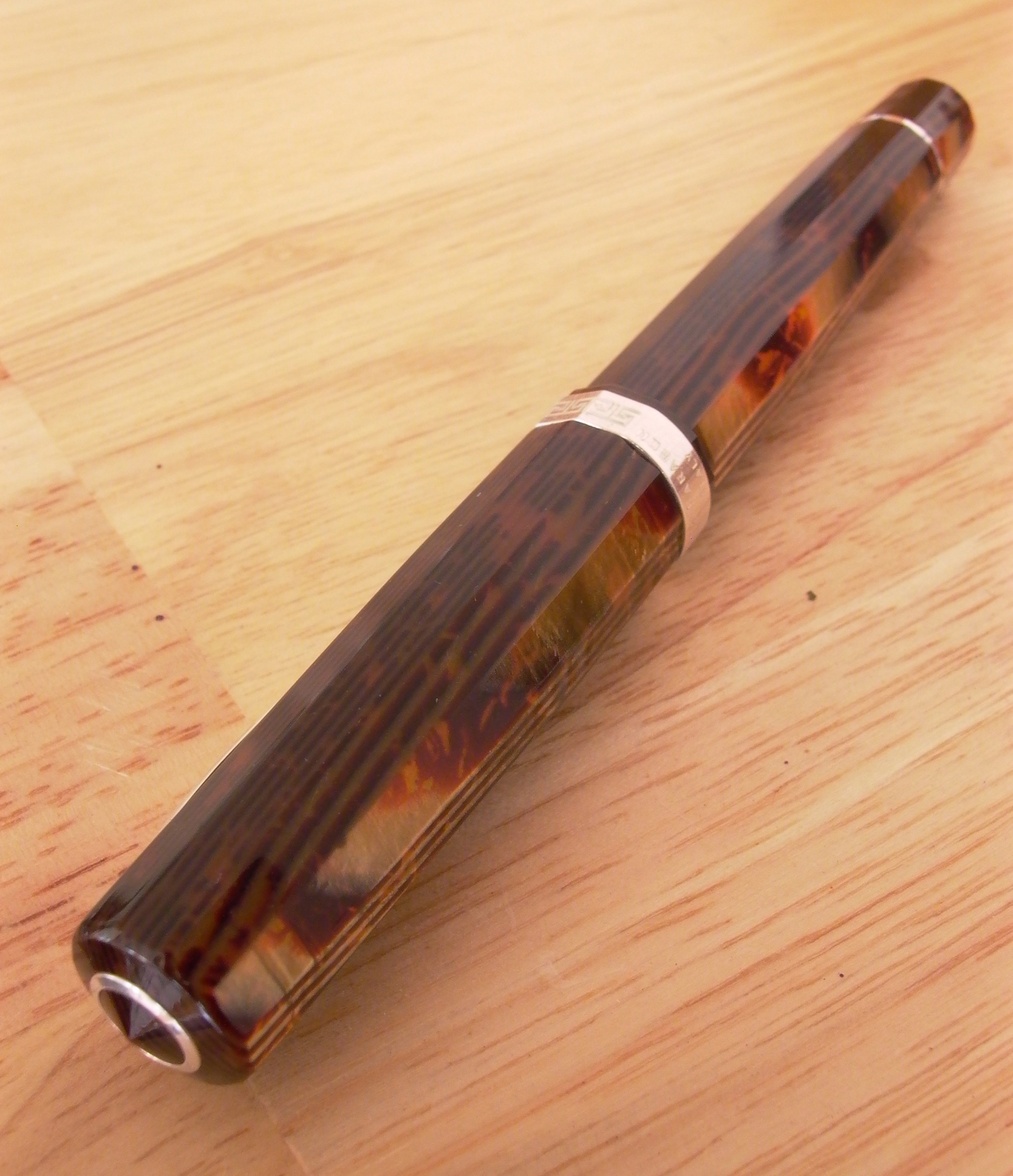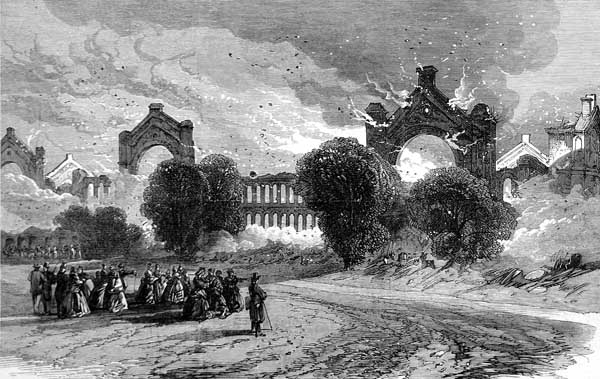|
International Exhibition Of 1862
The International Exhibition of 1862, or Great London Exposition, was a world's fair. It was held from 1 May to 1 November 1862, beside the gardens of the Royal Horticultural Society, South Kensington, London, England, on a site that now houses museums including the Natural History Museum and the Science Museum. Organisation The exposition was sponsored by the Royal Society of Arts, Manufactures and Trade, and featured over 28,000 exhibitors from 36 countries, representing a wide range of industry, technology, and the arts. William Sterndale Bennett composed music for the opening ceremony. All told, it attracted about 6.1 million visitors. Receipts (£459,632) were slightly above cost (£458,842), leaving a total profit of £790. It was held in South Kensington, London, on a site now occupied by the Natural History Museum. The buildings, which occupied 21 acres, were designed by Captain Francis Fowke of the Royal Engineers, and built by Lucas Brothers and Sir John Kelk. Th ... [...More Info...] [...Related Items...] OR: [Wikipedia] [Google] [Baidu] |
Analytical Engine
The Analytical Engine was a proposed mechanical general-purpose computer designed by English mathematician and computer pioneer Charles Babbage. It was first described in 1837 as the successor to Babbage's difference engine, which was a design for a simpler mechanical calculator. The Analytical Engine incorporated an arithmetic logic unit, control flow in the form of conditional branching and loops, and integrated memory, making it the first design for a general-purpose computer that could be described in modern terms as Turing-complete. In other words, the structure of the Analytical Engine was essentially the same as that which has dominated computer design in the electronic era. The Analytical Engine is one of the most successful achievements of Charles Babbage. Babbage was never able to complete construction of any of his machines due to conflicts with his chief engineer and inadequate funding. It was not until 1941 that Konrad Zuse built the first general-purpose com ... [...More Info...] [...Related Items...] OR: [Wikipedia] [Google] [Baidu] |
Clerestories
In architecture, a clerestory ( ; , also clearstory, clearstorey, or overstorey) is a high section of wall that contains windows above eye level. Its purpose is to admit light, fresh air, or both. Historically, ''clerestory'' denoted an upper level of a Roman basilica or of the nave of a Romanesque or Gothic church, the walls of which rise above the rooflines of the lower aisles and are pierced with windows. Similar structures have been used in transportation vehicles to provide additional lighting, ventilation, or headroom. History Ancient world The technology of the clerestory appears to originate in the temples of ancient Egypt. The term "clerestory" is applicable to Egyptian temples, where the lighting of the hall of columns was obtained over the stone roofs of the adjoining aisles, through gaps left in the vertical slabs of stone. Clerestory appeared in Egypt at least as early as the Amarna period. In the Minoan palaces of Crete such as Knossos, by contrast, lightwe ... [...More Info...] [...Related Items...] OR: [Wikipedia] [Google] [Baidu] |
Charles Babbage
Charles Babbage (; 26 December 1791 – 18 October 1871) was an English polymath. A mathematician, philosopher, inventor and mechanical engineer, Babbage originated the concept of a digital programmable computer. Babbage is considered by some to be " father of the computer". Babbage is credited with inventing the first mechanical computer, the Difference Engine, that eventually led to more complex electronic designs, though all the essential ideas of modern computers are to be found in Babbage's Analytical Engine, programmed using a principle openly borrowed from the Jacquard loom. Babbage had a broad range of interests in addition to his work on computers covered in his book ''Economy of Manufactures and Machinery''. His varied work in other fields has led him to be described as "pre-eminent" among the many polymaths of his century. Babbage, who died before the complete successful engineering of many of his designs, including his Difference Engine and Analytical Engi ... [...More Info...] [...Related Items...] OR: [Wikipedia] [Google] [Baidu] |
1862 Expo
Year 186 ( CLXXXVI) was a common year starting on Saturday (link will display the full calendar) of the Julian calendar. At the time, it was known as the Year of the Consulship of Aurelius and Glabrio (or, less frequently, year 939 ''Ab urbe condita''). The denomination 186 for this year has been used since the early medieval period, when the Anno Domini calendar era became the prevalent method in Europe for naming years. Events By place Roman Empire * Peasants in Gaul stage an anti-tax uprising under Maternus. * Roman governor Pertinax escapes an assassination attempt, by British usurpers. New Zealand * The Hatepe volcanic eruption extends Lake Taupō and makes skies red across the world. However, recent radiocarbon dating by R. Sparks has put the date at 233 AD ± 13 (95% confidence). Births * Ma Liang, Chinese official of the Shu Han state (d. 222) Deaths * April 21 – Apollonius the Apologist, Christian martyr * Bian Zhang, Chinese official and g ... [...More Info...] [...Related Items...] OR: [Wikipedia] [Google] [Baidu] |
Parkesine
Celluloids are a class of materials produced by mixing nitrocellulose and camphor, often with added dyes and other agents. Once much more common for its use as photographic film before the advent of safer methods, celluloid's common contemporary uses are table tennis balls, musical instruments, combs, office equipment, and guitar picks. History Nitrocellulose Nitrocellulose-based plastics slightly predate celluloid. Collodion, invented in 1848 and used as a wound dressing and an emulsion for photographic plates, is dried to a celluloid like film. Alexander Parkes The first celluloid as a bulk material for forming objects was made in 1855 in Birmingham, England, by Alexander Parkes, who was never able to see his invention reach full fruition, after his firm went bankrupt due to scale-up costs. Parkes patented his discovery as Parkesine in 1862 after realising a solid residue remained after evaporation of the solvent from photographic collodion. Parkes patented it as a clothi ... [...More Info...] [...Related Items...] OR: [Wikipedia] [Google] [Baidu] |
Submarine Communications Cable
A submarine communications cable is a cable laid on the sea bed between land-based stations to carry telecommunication signals across stretches of ocean and sea. The first submarine communications cables laid beginning in the 1850s carried telegraphy traffic, establishing the first instant telecommunications links between continents, such as the first transatlantic telegraph cable which became operational on 16 August 1858. Subsequent generations of cables carried telephone traffic, then data communications traffic. Modern cables use optical fibre technology to carry digital data, which includes telephone, Internet and private data traffic. Modern cables are typically about in diameter and weigh around for the deep-sea sections which comprise the majority of the run, although larger and heavier cables are used for shallow-water sections near shore. Submarine cables first connected all the world's continents (except Antarctica) when Java was connected to Darwin, Northern T ... [...More Info...] [...Related Items...] OR: [Wikipedia] [Google] [Baidu] |
Electrical Telegraph
Electrical telegraphs were point-to-point text messaging systems, primarily used from the 1840s until the late 20th century. It was the first electrical telecommunications system and the most widely used of a number of early messaging systems called '' telegraphs'', that were devised to communicate text messages quicker than physical transportation. Electrical telegraphy can be considered to be the first example of electrical engineering. Text telegraphy consisted of two or more geographically separated stations, called telegraph offices. The offices were connected by wires, usually supported overhead on utility poles. Many different electrical telegraph systems were invented, but the ones that became widespread fit into two broad categories. The first category consists of needle telegraphs in which a needle pointer is made to move electromagnetically with an electric current sent down the telegraph line. Early systems used multiple needles requiring multiple wires. The f ... [...More Info...] [...Related Items...] OR: [Wikipedia] [Google] [Baidu] |
The Great Exhibition
The Great Exhibition of the Works of Industry of All Nations, also known as the Great Exhibition or the Crystal Palace Exhibition (in reference to the temporary structure in which it was held), was an international exhibition which took place in Hyde Park, London, from 1 May to 15 October, 1851. It was the first in a series of World's Fairs, exhibitions of culture and industry that became popular in the 19th century. The event was organised by Henry Cole and Prince Albert, husband of Victoria, Queen of the United Kingdom. Famous people of the time attended the Great Exhibition, including Charles Darwin, Karl Marx, Michael Faraday (who assisted with the planning and judging of exhibits), Samuel Colt, members of the Orléanist Royal Family and the writers Charlotte Brontë, Charles Dickens, Lewis Carroll, George Eliot, Alfred Tennyson and William Makepeace Thackeray. The opening music, under the superintendence of William Sterndale Bennett, was directed by Sir ... [...More Info...] [...Related Items...] OR: [Wikipedia] [Google] [Baidu] |
Industrial Revolution
The Industrial Revolution was the transition to new manufacturing processes in Great Britain, continental Europe, and the United States, that occurred during the period from around 1760 to about 1820–1840. This transition included going from hand production methods to machines, new chemical manufacturing and iron production processes, the increasing use of steam power and water power, the development of machine tools and the rise of the mechanized factory system. Output greatly increased, and a result was an unprecedented rise in population and in the rate of population growth. Textiles were the dominant industry of the Industrial Revolution in terms of employment, value of output and capital invested. The textile industry was also the first to use modern production methods. The Industrial Revolution began in Great Britain, and many of the technological and architectural innovations were of British origin. By the mid-18th century, Britain was the world's leadin ... [...More Info...] [...Related Items...] OR: [Wikipedia] [Google] [Baidu] |
Alexandra Palace
Alexandra Palace is a Grade II listed entertainment and sports venue in London, situated between Wood Green and Muswell Hill in the London Borough of Haringey. It is built on the site of Tottenham Wood and the later Tottenham Wood Farm. Originally built by John Johnson and Alfred Meeson, it opened in 1873 but following a fire two weeks after its opening, was rebuilt by Johnson. Intended as "The People's Palace" and often referred to as "Ally Pally", its purpose was to serve as a public centre of recreation, education and entertainment; North London's counterpart to the Crystal Palace in South London. At first a private venture, in 1900, the owners planned to sell it and Alexandra Park for development. A group of neighbouring local authorities managed to acquire it. An Act of Parliament created the Alexandra Palace and Park Trust. The Act required the trustees to maintain the building and park and make them available for the free use and recreation of the public forever. Th ... [...More Info...] [...Related Items...] OR: [Wikipedia] [Google] [Baidu] |
Granville Leveson-Gower, 2nd Earl Granville
Granville George Leveson-Gower, 2nd Earl Granville, (11 May 181531 March 1891), styled Lord Leveson until 1846, was a British Liberal statesman and diplomat from the Leveson-Gower family. He is best remembered for his service as Secretary of State for Foreign Affairs. His foreign policy was based on patience, peace, and no alliances; it kept Britain free from European wars and improved relations with the United States after the strain during the American Civil War. Background and education Leveson-Gower was born in London, the eldest son of Granville Leveson-Gower, 1st Earl Granville and Lady Harriet Cavendish, daughter of Lady Georgiana Spencer and William Cavendish, 5th Duke of Devonshire. His father was a younger son of Granville Leveson-Gower, 1st Marquess of Stafford and his third wife; an elder son with his second wife (a daughter of the 1st Duke of Bridgwater) became the 2nd Marquess of Stafford, and his marriage with the daughter and heiress of the 18th Ear ... [...More Info...] [...Related Items...] OR: [Wikipedia] [Google] [Baidu] |

.jpg)

_School_-_Charles_Babbage_(1792–1871)_-_814168_-_National_Trust.jpg)





